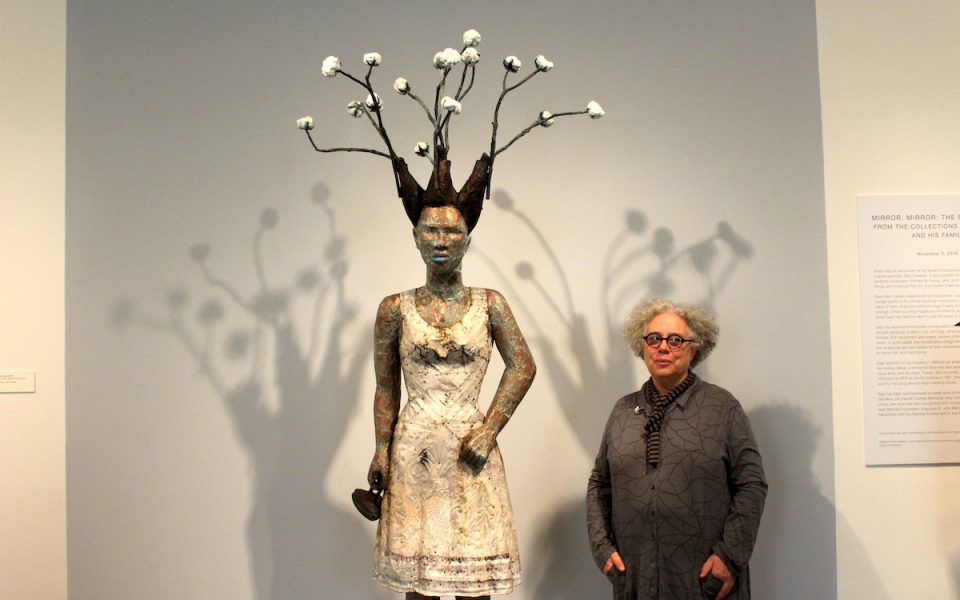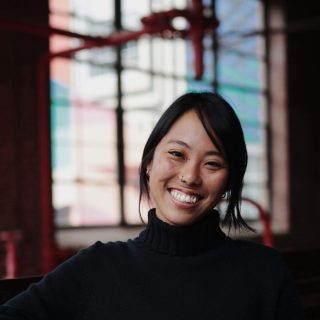Alison Saar stands next to her reflection, a woman whose torso, arms and legs — rather than made of flesh like hers — are wrapped in thin metal sheets, nailed together along incongruent seams across her body.
The doppelganger measures just under five feet tall, same as Saar herself. She stands in juxtaposition, her left leg gently bent forward while her right plants firmly into the ground. Her right hand lifts a black, cast-iron skillet up to her face, like a mirror. A face appears out of the pan and gazes back at the sculpture.
-

Alison Saar stands next to her piece, “Mirror, Mirror; Mulatta Seeking Inner Negress” (photo by Sayaka Matsuoka) -

“Mirror, Mirror; Mulatta Seeking Inner Negress” by Alison Saar (photo by Sayaka Matsuoka)
“Mirror, Mirror; Mulatta Seeking Inner Negress” speaks directly to Saar’s personal experience of growing up as a biracial woman.
The daughter of a white father and a black mother, the renowned artist often gets mistaken as white because of her fair complexion, and uses art to contemplate her split identity.
“I was hyperconscious of the African-American side of my ancestry,” Saar says in an interview, “just because, being perceived as white or looking white, that was always something that I struggled with.”
Saar grew up in Los Angeles, raised by two artists: Richard Saar, an arts conservator and ceramicist, and Betye Saar, an assemblage and collage artist whose work tackled racism and identity and which played a vital role in the Black Arts Movement of the ’70s. Much like her mother’s, Saar’s pieces also deal with issues of race, gender and identity.
A new exhibit at the Weatherspoon Art Museum in Greensboro titled ‘Mirror, Mirror’: The Prints of Alison Saar, displays decades of the artist’s work, forming a timeline of her earlier pieces from the ’90s to newer ones created in the past few years. And while she may be perceived as white, much of her work depicts darker skinned individuals, most of them women.
-

Alison Saar, Mirror Mirror: Mulatta Seeking Inner Negress II, 2014, Woodcut on chine collé, ed. 30. Collection of Jordan D. Schnitzer. -

Alison Saar, High Cotton, edition 1/8, 2017, linocut and offset monotype woodcut, 25 1/8 x 16 in. Collection of Jordan D. Schnitzer. -

Alison Saar, Coup de Grâce, lithograph, edition 6/16, 2012, 19 1/4 x 25 in. Collection of Jordan D. Schnitzer.
“Those were the customs and the traditions, the family that I loved being around,” Saar says of her black family. “It was the food, it was the music, it was the dancing.”
Saar says she was estranged from her father’s side of the family for a few years; she’s always felt closer to her mother’s half of the family.
On a wall near the sculpture hangs a corresponding woodcut print of the mulatta, this time clothed in a white dress, her back to the viewer, the black face peering out from the skillet at the audience. Many of Saar’s prints in the exhibit have corresponding sculptures that inspired the two-dimensional work. Nearby, Saar points out a print titled “Washtub Blues,” in which a black maid peers into a large tub of water that reflects her black face.

This piece, which Saar says is one of her favorites in the show, highlights the invisibility and erasure of the efforts of laborers.
“It talks about the failure of recognition of domestic workers and people that are working within other people’s homes and households and how they’re faceless,” Saar says.
Like the print of her self-portrait, the woman in “Washtub Blues” has her back turned to the viewer, the only depiction of her face shown as a secondary reflection in the murky water. Floating on the surface, the woman’s face is simple, showing just her lips, her white cap and two blank eyes. In fact, all of the people depicted in Saar’s works have eyes that are blank.
“They’re kind of masks in some sort of way,” Saar explains during an artist talk on Nov. 7. She talks about drawing inspiration from images of early slaves who were brought to the country and thinking about how they maintained their dignity in times of unimaginable degradation.
“How do you survive those things and how do you survive those affronts?” she asks. “And one of the ways you do that is by not giving them the satisfaction of not returning that gaze. That you still have control over this.”
Themes of labor and slavery recur throughout Saar’s work. A lover of found objects, the artist often casts images of individuals on old sugar or seed sacks, and portrays her characters holding tools of labor like sickles, hoes, irons and skillets, now empowered in her pieces as weapons. Reclaiming the black experience and uplifting the stories of her heritage embodies the core of Saar’s work. It also helps navigate ideas of who she is not only as an artist, but as an individual as well.
“I think it’s really important to understand who you are and if you don’t understand who you are, to really look at who you are,” she says. “Even if you are talking about things that are happening out in the world, I think it’s important to come from a really personal point of view.
“I guess I am a storyteller,” Saar continues. “I can’t write at all, so I have to do it through art.”
“Mirror, Mirror: The Prints of Alison Saar” will be on display at the Weatherspoon Art Museum through Feb. 23, 2020. Learn more about the exhibit here.
Join the First Amendment Society, a membership that goes directly to funding TCB‘s newsroom.
We believe that reporting can save the world.
The TCB First Amendment Society recognizes the vital role of a free, unfettered press with a bundling of local experiences designed to build community, and unique engagements with our newsroom that will help you understand, and shape, local journalism’s critical role in uplifting the people in our cities.
All revenue goes directly into the newsroom as reporters’ salaries and freelance commissions.


Leave a Reply